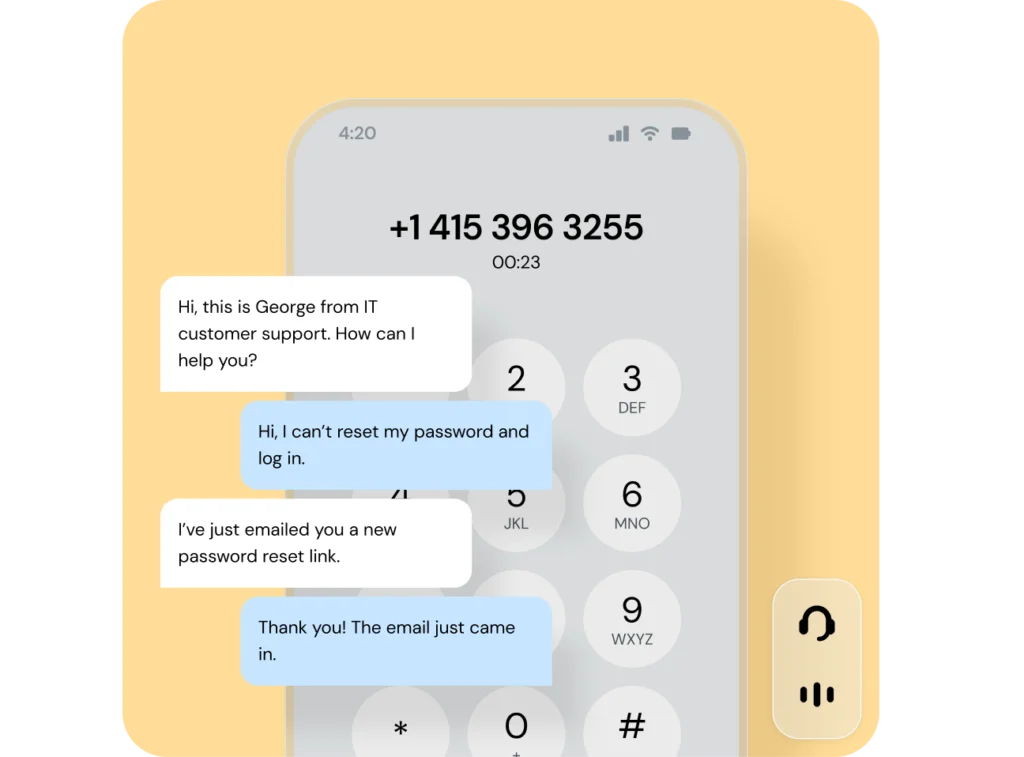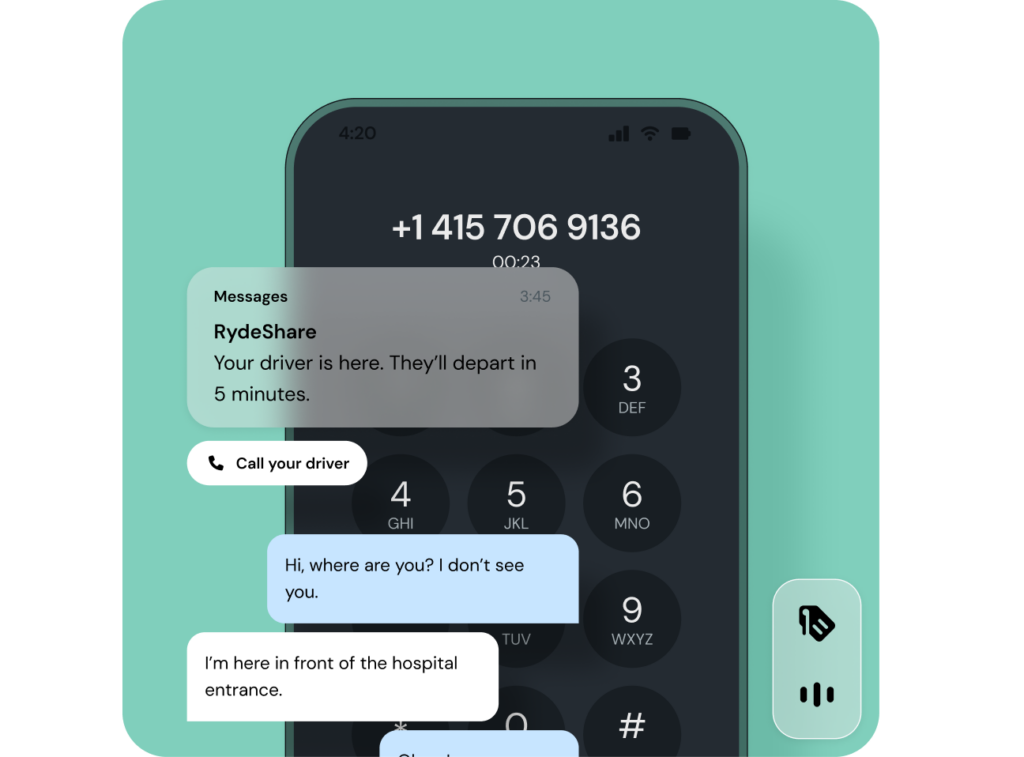Insights, Products
Programmable voice in action: Examples for tech, healthcare, financial services, and e-commerce

Insights, Products

What if the phone call evolved – routing itself, authenticating the caller, masking numbers, and solving problems before an agent even picks up? That’s exactly what a modern programmable voice API can offer.
For enterprises, this means a flexible, API-driven solution built to reduce fraud, send appointment reminders via voice, answer pre- and post-sales questions, and fix delivery issues in real time. It’s the difference between struggling with outdated voice infrastructure and offering a modern voice setup.
Wondering what this would look like in practice for your enterprise? That’s exactly what we’ll explore in this blog post for different industries.
Programmable voice is an API- and SDK-powered way to embed real-time calling features into your apps or workflows. Voice APIs plug directly into modern tech stacks and connects with AI tools, CRMs, and automated workflows making your voice communication more efficient.
For example, you can use it to trigger voice notifications, route calls intelligently, or document conversations for compliance and training. And everything is customizable: from how the system handles calls to how you can adapt it to your needs.
Commonly-used features include things like:
When used strategically, these features accelerate workflows and reduce support costs. They also boost customer satisfaction during high-stakes moments like confirming a last-minute medical appointment, resolving a failed delivery, verifying a flagged transaction, or finalizing a high-value purchase.
And adoption of programmable voice is soaring. According to recent data from Deepgram, 84% of organizations plan to increase their voice technology investment over the next year. For 67%, voice is foundational to their product and strategy.
On the other hand, sleeping on upgrading your voice infrastructure, could cost your enterprise in the long run.
Even with efficient support channels like email or chatbots, Sinch data reveals that customers also rely on being able to call a company – especially in critical situations, for instance after a fraud alert or when talking about sensitive information.
That’s when your voice service needs to be quick, reliable, and adaptable. However, across industries, businesses are hitting walls when it comes to speed, trust, and personalization if their voice infrastructure doesn’t meet modern standards and customer expectations.
The results? Inefficient internal processes, reduced revenue, and lost customer trust.
In the gig economy, failed deliveries happen daily because drivers can’t reach customers who won’t pick up calls from unknown numbers. In e-commerce, cart abandonment spikes during peak seasons if there’s no seamless way to connect a frustrated customer with a live agent before they bounce.
Tech platforms and healthcare providers are overwhelmed by call volumes and inefficient routing. Riders struggle to get timely help. Doctors can’t triage urgent needs fast enough when nearly half of calls are routine. Financial services teams spend hours chasing verification or guiding users through complex flows that could’ve been automated with smarter voice workflows.
Voice fraud is rising and consumers expect companies to keep them safe. 84% of Americans believe the companies they do business with are responsible for their digital privacy. Without trusted caller ID or secure in-app calling, businesses might be missing the mark in keeping their customers safe.
This is where programmable voice starts to earn its keep because it lets you add that extra layer of security to your voice services.

And if you’re wondering if it’s all worth it – listen to your customers. People very much still want to connect over the phone with businesses and programmable voice adds that human touch while keeping digital efficiency.
Whether it’s embedding text-to-speech in various languages for adding that personal touch or enabling secure call masking between users, programmable voice offers personalization and flexibility across the entire customer journey. You can also record and transcribe calls to support agents to get insights that go far beyond traditional support use cases.
How exactly? Let’s dig into how businesses in tech, e-commerce, healthcare, and finance are already putting voice APIs to work and how you can, too.
For gig economy platforms like Instacart, Uber, and DoorDash, failed deliveries often come down to communication issues.
For one: Customers don’t answer calls from unknown numbers. In the U.S., studies have found that almost half of consumers (41%) refuse to pick up the phone if they don’t recognize the number.
So, when a delivery driver is trying to reach a customer when they’re trying to get past the front gate or need clearer directions, chances are they’ll be ignored. This often leads to a negative customer experience and failed last-mile deliveries.
Aside from customers not trusting unknown numbers, there’s also a risk that allowing employees and customers to see each other’s numbers creates the possibility to later offer services outside of your company – undermining your business.
But enhancing trust, ensuring reachability, and safeguarding your business at the same time sounds like an impossible task. It really isn’t!
Programmable voice solves all of these problems by enabling secure in-app calling or call masking for traditional phones. As a result, employees can call customers directly without revealing their personal numbers and calls appear as verified IDs, boosting pickup rates.
And it works both ways: It’s not only employees that can call customers without having to show their private call information. Customers can also reach out to drivers or support without having to reveal their personal number. This adds a layer of security and enhances trust in your services.

Programmable voice also adds accountability. You can log, record, and transcribe calls to verify delivery attempts and resolve disputes faster.
With a single voice API, gig economy platforms can reduce failed deliveries, prevent revenue leakage, and streamline the entire delivery experience without compromising privacy or user experience.
It’s a minimal integration that improves delivery accuracy, speeds up driver coordination, and cuts support overhead.
Healthcare is, and always has been, a voice-first industry. When someone’s sick, confused, or scared, they want to talk to a real human.
But the result? Call centers are overwhelmed.
In the Netherlands alone, doctors field over seven million calls per day, with nearly 43% of them coming from patients who don’t actually need urgent care. That volume makes it hard to prioritize those who do.
That’s exactly what Dutch MedTech company MINDD set out to fix. Using Sinch’s Voice API and AI chatbot builder, they created a voice-enabled triage bot that asks patients to describe their symptoms in natural language, interprets over 70 medical issues, and then routes the call based on urgency.
Critical cases are pushed through instantly. Routine concerns get queued. And when the bot passes the call to a human agent, it sends along structured data, so conversations are shorter and more targeted.
This means faster response times, fewer disruptions, and more bandwidth for doctors to focus on critical cases.
For banks and financial services, customer communication is under pressure from both sides.
Customers expect highly-personalized experiences – reminders about loan renewals, alerts about suspicious charges, or help navigating investment options. But at the same time, financial service customers demand strong security for every touchpoint.
Programmable voice bridges the gap.
Sinch’s 2025 State of customer communications report shows that while 83% of consumers want personalization based on their financial situation, they also expect these communications to be safe. And hundreds of financial leaders we surveyed for the report agreed, citing security as one of their biggest focus areas.
feel safer when extra steps are taken to protect their data.
see security as their biggest communication challenge.
Programmable voice lets you embed secure, customizable voice interactions into your app, CRM, or website, so your customers can get a callback about a fraud alert, ask questions through in-app calling, or verify their identity with a phone-based OTP.
From real-time voice alerts to call masking and encrypted in-app calls, programmable voice brings a human touch to your most sensitive conversations without sacrificing compliance.
In e-commerce, voice might feel outdated… until something goes wrong.
Customers glide through checkout flows, browse product pages with the help of AI, and interact via chatbots. But the moment there’s a hiccup, like a failed payment or a confusing return, they want to talk to someone now.
Programmable voice gives customers a direct line to support – right when they need it most.
With embedded in-app calling, you can let users speak with a support agent right from your app – no switching devices or copy-pasting order numbers. Add click-to-call buttons on your website to recover lost sales in real time: If there’s a checkout error, the customer can call and fix it before abandoning the cart.
And when call volumes spike – say, after Black Friday or during the return season – you can combine programmable voice with Elastic SIP Trunking that easily scales and provides crystal-clear call quality, flexible capacity, and lower costs without requiring an overhaul of your tech stack.
LiveVox, a leading contact center platform, used Sinch’s Voice API and Elastic SIP Trunking to unify voice and SMS callback management, enabling seamless cross-channel support. With a single dashboard, they cut troubleshooting time and gave users a frictionless way to reconnect – boosting satisfaction and operational efficiency.
“Sinch has truly empowered our platform by making it easy to manage both SMS and voice. Our clients appreciate the flexibility and seamless callback features that enhance the customer journey.“
Programmable voice helps you manage high-stakes conversations, from failed deliveries to urgent healthcare calls, quickly, securely, and without disrupting the user experience.
Sinch’s Programmable Voice API is cloud-based, developer-friendly, and flexible enough to integrate into your apps, websites, or backend systems. Whether you’re sending one-time notifications or managing complex, real-time interactions, it’s built to scale with your needs.
Security and customer experience aren’t trade-offs. With features like call masking, in-app calling, and AI-driven call routing, you can offer branded, compliant interactions at scale.
Whether you’re preparing for peak seasons or future-proofing your CX stack, voice doesn’t have to be complicated.
With the right tools, it becomes the fastest path to frictionless support across every channel.
Explore Sinch’s Programmable Voice API to build smarter voice experiences.